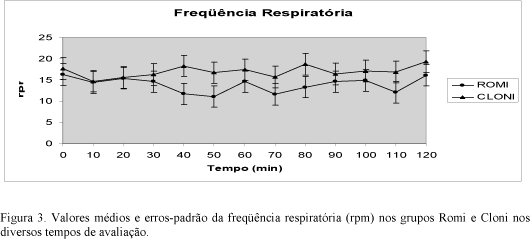Cardiovascular alterations and analgesia in 14 dogs submitted to epidural administration of clonidine or romifidine to enable coxofemoral surgery were evaluated. Dogs were separated in two groups: Cloni group received 150µg of clonidine and Romi group, 20µg/kg of romifidine. Anesthetic induction was performed using propofol (8mg/kg) and maintenance using halothane and O2 in spontaneous breathing. The puncture of epidural space was performed just after anesthetic induction. Heart rate and respiratory rate, systolic arterial rate, hemoglobin oxygen saturation and halothane concentration were assessed before anesthetic induction, and at each 10 minutes until the end of the surgery. Samples of arterial blood were collected after anesthesic induction and at the end of the surgical procedure in order to assess pH, PaCO2, PaO2, SaO2, BE and HCO3- levels. The analgesia degree (intense, middle or inadequated) was evaluated for two postoperative hours. Numerical data were analysed with ANOVA and Bonferroni's test (P< 0.05). Dogs of Romi group had bradycardia, bradyarrhrytmia, and hypertension. The heart rate and systolic arterial pressure in the Cloni group were within the physiologic variation parameter to dogs. In conclusion epidural administration of clonidine or romifidine produce intense intraoperative analgesia, with no respiratory depression, and middle analgesia for two postoperative hours. Bradycardia and hypotension were not observed with epidural clonidine, however, bradyarrhytmia and hypertension ocurred with epidural romifidine.
dog; epidural; clonidine; romifidine




